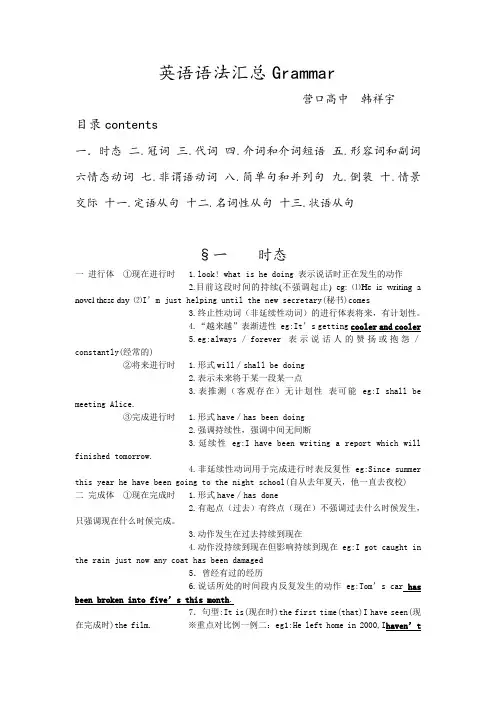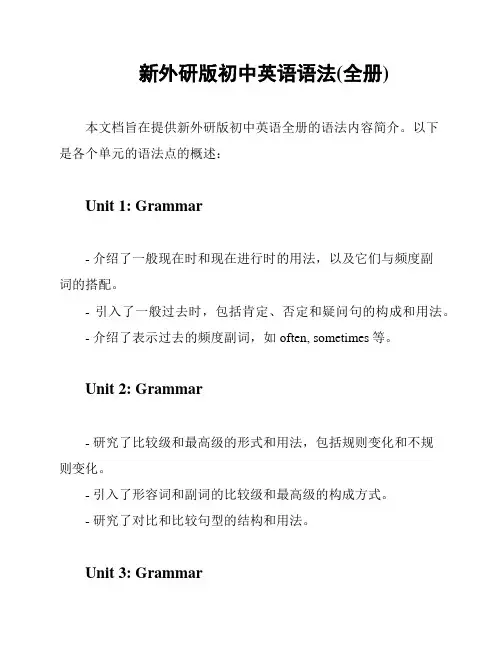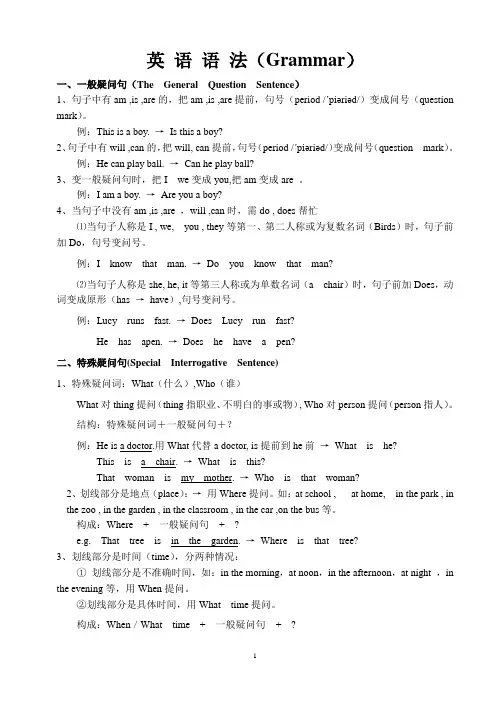基本英语语法英语grammar精讲内容
- 格式:pptx
- 大小:208.49 KB
- 文档页数:21

柯林斯英语语法系列柯林斯英语语法系列是一套系统全面的语法教材,它涵盖了英语语法的各个方面并以清晰的解释和示例帮助学习者掌握相关知识。
本文将为您提供柯林斯英语语法系列的相关参考内容,旨在帮助您更好地理解和学习英语语法。
1. 《柯林斯英语语法 - 基础篇》(Collins Easy Learning English Grammar):- 名词:介绍名词的分类和数的变化规则。
- 代词:解释人称代词、指示代词、不定代词等的用法。
- 动词:介绍动词的时态、语态、情态动词等基本知识。
- 形容词和副词:解释形容词和副词在句子中的修饰作用。
- 句子结构:讲解主语、谓语、宾语等在句子中的关系和顺序。
2. 《柯林斯英语语法 - 进阶篇》(Collins Cobuild English Grammar):- 从句:详细介绍并区分主从句、名词性从句、定语从句和状语从句等。
- 时态和语态:深入讲解各种时态和语态的构成和用法,并提供例句进行说明。
- 介词和连词:解释介词和连词在句子中的连接作用,并列出常见的介词和连词。
- 句型变化:介绍句子的各种变化形式,如倒装、省略、强调等。
3. 《柯林斯英语语法 - 高级篇》(Collins Cobuild AdvancedEnglish Grammar):- 语法关系:详细介绍句子成分之间的语法关系,如主谓关系、同位关系、并列关系等。
- 修饰语的用法:讲解不同类型的修饰语及其用法,如形容词短语、副词短语和分词等。
- 状语从句的种类:介绍各种状语从句的用法,如时间状语从句、条件状语从句等。
- 引导词的用法:解释不同引导词的用法和意义,如虚拟语气中的if、would等。
以上仅是柯林斯英语语法系列的一部分内容,该系列还涉及英语语法的其他方面,如形容词和副词的比较级和最高级、被动语态的用法等。
柯林斯英语语法系列以其简明扼要的解释、丰富的例句和习题,帮助学习者全面理解和巩固英语语法知识。
通过阅读和学习柯林斯英语语法系列,您可以逐步掌握英语语法的基本知识和高级技巧,并能够正确运用于日常交流和书面表达中。


英语语法汇总Grammar营口高中韩祥宇目录contents一.时态二.冠词三.代词四.介词和介词短语五.形容词和副词六情态动词七.非谓语动词八.简单句和并列句九.倒装十.情景交际十一.定语从句十二.名词性从句十三.状语从句§一时态一进行体①现在进行时 1.look! what is he doing 表示说话时正在发生的动作2.目前这段时间的持续(不强调起止) eg:⑴He is writing a novel these day⑵I’m just helping until the new secretary(秘书)comes3.终止性动词(非延续性动词)的进行体表将来,有计划性。
4.“越来越”表渐进性 eg:It’s getting cooler and cooler5.eg:always/forever表示说话人的赞扬或抱怨/constantly(经常的)②将来进行时 1.形式will/shall be doing2.表示未来将于某一段某一点3.表推测(客观存在)无计划性表可能 eg:I shall be meeting Alice.③完成进行时 1.形式have/has been doing2.强调持续性,强调中间无间断3.延续性 eg:I have been writing a report which will finished tomorrow.4.非延续性动词用于完成进行时表反复性 eg:Since summer this year he have been going to the night school(自从去年夏天,他一直去夜校)二完成体①现在完成时 1.形式have/has done2.有起点(过去)有终点(现在)不强调过去什么时候发生,只强调现在什么时候完成。
3.动作发生在过去持续到现在4.动作没持续到现在但影响持续到现在 eg:I got caught in the rain just now any coat has been damaged5.曾经有过的经历6.说话所处的时间段内反复发生的动作 eg:Tom’s car has been broken into five’s this month.7.句型:It is(现在时)the first time(that)I have seen(现在完成时)the film.seen(现在完成时) ever since.eg2: When he came to,he wondered how long he had lain(躺)on the ground.②将来完成时 1.形式will/shall have done2.by+将来时间状语 eg:By the end of this year,I will have finished this job.3.主将从现eg:{By(将来时间点) the time I arrived(现在时)}(时间状语从句),Tom will have left.三一般体①一般现在时 1.表示性质,状态,属性,特征2.表示频度,经常性※反例:I didn’t ask for the name list how has it landed on my dask?3.客观事实(书评、影评、真理、文学评论)4.固定时间发生的事用现在时替代将来时。



英语零基础语法大全精讲English grammar may seem intimidating at first, but it doesn't have to be. With a little bit of practice and patience, you can master the basics of English grammar.Here's a breakdown of the most important grammar rules to get you started:1. Nouns: A noun is a person, place, or thing. Nouns can be singular or plural, and they can be used as subjects, objects, or possessives in a sentence.2. Verbs: A verb is an action word. Verbs can be in the past, present, or future tense, and they can be regular or irregular.3. Adjectives: An adjective is a word that describes a noun. Adjectives can be used to convey size, shape, color, and many other qualities.4. Adverbs: An adverb is a word that describes a verb or adjective. Adverbs can be used to convey time, manner, place, and degree.5. Pronouns: A pronoun is a word that takes the place ofa noun. Pronouns can be used to avoid repetition, and they can be subject or object pronouns.6. Prepositions: A preposition is a word that shows the relationship between a noun or pronoun and other words in a sentence. Common prepositions include in, on, at, and by.7. Conjunctions: A conjunction is a word that connects words or phrases in a sentence. Common conjunctions include and, or, but, and so.8. Articles: An article is a word that comes before anoun to indicate whether it is definite or indefinite. The definite article is 'the', and the indefinite articles are 'a' and 'an'.By learning and practicing these basic grammar rules, you can improve your English skills and communicate more effectively in both writing and speaking. Don't be afraid to make mistakes – they're all part of the learning process. Keep practicing and soon you'll be a grammar pro!。

新外研版初中英语语法(全册)
本文档旨在提供新外研版初中英语全册的语法内容简介。
以下
是各个单元的语法点的概述:
Unit 1: Grammar
- 介绍了一般现在时和现在进行时的用法,以及它们与频度副
词的搭配。
- 引入了一般过去时,包括肯定、否定和疑问句的构成和用法。
- 介绍了表示过去的频度副词,如often, sometimes等。
Unit 2: Grammar
- 研究了比较级和最高级的形式和用法,包括规则变化和不规
则变化。
- 引入了形容词和副词的比较级和最高级的构成方式。
- 研究了对比和比较句型的结构和用法。
Unit 3: Grammar
- 讨论了一般将来时的构成和用法,包括will和be going to的
区别。
- 研究了使用一般将来时表达计划、打算和预测。
- 引入了时间状语从句,并解释了如何在句子中使用这些从句。
Unit 4: Grammar
- 研究了现在完成时的构成和用法,包括表示经验、结果和变
化的情况。
- 引入了表示经验和时间段的时间状语。
- 讨论了for和since在现在完成时中的使用方式。
Unit 5: Grammar
- 探讨了一般过去将来时的构成和用法,包括would和
was/were going to的区别。
- 研究了将来计划和意图的表达方式。
- 引入了并列连词和条件句的结构和使用。
...(依此类推,简要介绍其他单元的语法点)
通过学习这本教材,学生将能够掌握初中英语的基本语法知识。
希望本文档对您有所帮助。

英语语法(Grammar)一、一般疑问句(The General Question Sentence)1、句子中有am ,is ,are的,把am ,is ,are提前,句号(period /΄piəriəd/)变成问号(question mark)。
例:This is a boy. →Is this a boy?2、句子中有will ,can的,把will, can提前,句号(period /΄piəriəd/)变成问号(question mark)。
例:He can play ball. →Can he play ball?3、变一般疑问句时,把I we变成you,把am变成are 。
例:I am a boy. →Are you a boy?4、当句子中没有am ,is ,are ,will ,can时,需do , does帮忙⑴当句子人称是I , we, you , they等第一、第二人称或为复数名词(Birds)时,句子前加Do,句号变问号。
例:I know that man. →Do you know that man?⑵当句子人称是she, he, it等第三人称或为单数名词(a chair)时,句子前加Does,动词变成原形(has →have),句号变问号。
例:Lucy runs fast. →Does Lucy run fast?He has apen. →Does he have a pen?二、特殊疑问句(Special Interrogative Sentence)1、特殊疑问词:What(什么),Who(谁)What对thing提问(thing指职业、不明白的事或物), Who对person提问(person指人)。
结构:特殊疑问词+一般疑问句+?例:He is a doctor.用What代替a doctor, is提前到he前→What is he?This is a chair. →What is this?That woman is my mother. →Who is that woman?2、划线部分是地点(place):→用Where提问。

牛津英语语法要点精讲朗文英语语法Oxford English Grammar Basics and Longman English GrammarIntroductionEnglish grammar is a complex and important topic for anyone learning the language. In this document, we will discuss some key points from two popular English grammar guides - Oxford English Grammar Basics and Longman English Grammar. These resources provide comprehensive explanations and examples to help learners understand the rules and structures of English grammar.1. Parts of SpeechBoth Oxford English Grammar Basics and Longman English Grammar cover the basic parts of speech in English, including nouns, pronouns, verbs, adjectives, adverbs, prepositions, conjunctions, and interjections. Understanding the function of each part of speech is essential for constructing grammatically correct sentences.2. Sentence StructureSentence structure is a fundamental aspect of English grammar. Both resources explain how to form different types of sentences, including simple, compound, complex, and compound-complex sentences. They also discuss word order, subject-verb agreement, and the importance of punctuation in shaping meaning.3. Verb TensesVerbs play a crucial role in expressing actions, states, and time in English. Oxford English Grammar Basics and Longman English Grammar provide detailed explanations of the various verb tenses, including present, past, future, present continuous, past continuous, future continuous, present perfect, past perfect, and future perfect. Mastering verb tenses is essential for effective communication in English.4. Subject-Verb AgreementSubject-verb agreement refers to the relationship between the subject and verb in a sentence. Both resources emphasize the importance of ensuring that the verb agrees with the subject in terms of number and person. Understanding subject-verb agreement helps learners avoid common errors in their writing and speaking.5. ModifiersModifiers are words or phrases that provide additional information about nouns, pronouns, verbs, or other modifiers in a sentence. Oxford English Grammar Basics and Longman English Grammar explain the different types of modifiers, such as adjectives, adverbs, and prepositional phrases. Using modifiers effectively can enhance the clarity and precision of writing.6. Sentence Fragments and Run-On SentencesSentence fragments are incomplete sentences that lack a subject, verb, or complete thought. Run-on sentences, on the other hand, are lengthy sentences that lack appropriate punctuation or conjunctions. Both resources offer guidance on how to identify and correct sentence fragments and run-on sentences to improve the overall coherence of writing.7. ParallelismParallelism involves using similar grammatical structures for items in a list, series, or comparison. Oxford English Grammar Basics and Longman English Grammar highlight the importance of maintaining parallel structure to enhance the readability and flow of sentences. Consistent parallelism can make writing more cohesive and engaging.8. Relative ClausesRelative clauses provide additional information about a noun or pronoun in a sentence. Both resources explain how to form and use relative clauses effectively, including defining and non-defining relative clauses. Understanding relative clauses helps learners expand their sentence structures and convey complex ideas more clearly.ConclusionIn conclusion, Oxford English Grammar Basics and Longman English Grammar are valuable resources for anyone looking to improve their understanding of English grammar. By focusing on key concepts such as parts of speech, sentence structure, verb tenses, subject-verb agreement, modifiers, sentence fragments, run-on sentences, parallelism, and relative clauses, learners can enhance their language skills and communicate more effectively in English. Continuous practice and application of these grammar rules will lead to greater confidence and proficiency in using the English language.。


英语语法精讲引言:语法是学习英语的基础,它是语言的骨架,决定了句子的结构和意义。
掌握好英语语法对于提高英语水平和表达能力至关重要。
本教案将从基础概念到高级语法知识,系统地介绍英语语法的各个方面。
一、句子结构句子是语言表达的基本单位,它由主语、谓语和宾语构成。
主语是句子的主要话题,谓语是主语所做的动作或状态,宾语是动作的承受者或影响者。
在句子结构中,我们还需要了解补语、定语和状语的作用和用法。
二、时态和语态时态和语态是英语中非常重要的语法概念。
时态表示动作发生的时间,包括一般现在时、一般过去时、一般将来时等。
语态表示动作的主动或被动形式,包括主动语态和被动语态。
深入理解时态和语态的用法,可以帮助我们准确地表达过去、现在和将来的动作。
三、名词和代词名词是指人、事物、地点、抽象概念等,它是句子中的主语、宾语和补语。
代词是用来代替名词的词语,它可以简化句子结构,提高语言的流畅性。
在学习名词和代词时,我们需要了解它们的性别、单复数、所有格等变化规则。
四、形容词和副词形容词用来描述名词的特征和性质,副词用来修饰动词、形容词和其他副词。
形容词和副词的正确使用可以使语言更加生动、具体和精确。
在学习形容词和副词时,我们需要了解它们的比较级和最高级形式,以及修饰位置的不同。
五、介词和连词介词用来表示名词或代词与其他词之间的关系,连词用来连接句子和句子中的各个成分。
介词和连词的运用可以使句子更加连贯和流畅。
在学习介词和连词时,我们需要掌握它们的常见用法和搭配。
六、从句和复合句从句是一个完整的句子,它可以作为句子的一部分出现。
复合句是由一个主句和一个或多个从句构成的句子。
了解从句和复合句的结构和用法,可以帮助我们更好地理解复杂的句子结构和表达逻辑关系。
七、虚拟语气和倒装句虚拟语气用来表示与事实相反的假设或愿望,倒装句是将句子中的主语和谓语的位置颠倒。
掌握虚拟语气和倒装句的用法,可以使我们的语言更加地丰富和变化。
结语:语法是英语学习的基石,掌握好语法知识对于提高英语水平至关重要。
英语语法100讲精讲English Answer:Grammar is an essential aspect of language learning. It helps us understand how words and phrases are organized to create meaningful sentences. By studying grammar, we can improve our communication skills and express our thoughts more accurately. In this article, I will discuss 100 important grammar points that will help you enhance your English language proficiency.Let's start with the basics. One fundamental aspect of grammar is understanding the parts of speech. Nouns, verbs, adjectives, adverbs, pronouns, prepositions, conjunctions, and interjections are the building blocks of sentences. Each of these parts of speech has a specific role in conveying meaning. For example, nouns are used to name people, places, things, or ideas, while verbs describe actions or states of being. Understanding the functions of each part of speech is crucial for constructinggrammatically correct sentences.Moving on, let's discuss sentence structure. In English, sentences typically follow a subject-verb-object order. However, there are variations to this basic structure, such as questions, commands, and exclamations. For instance, ina question, the subject and verb are inverted, and in a command, the subject is often implied. Learning these sentence structures will enable you to communicateeffectively in different contexts.Next, let's delve into verb tenses. English has avariety of tenses, including present, past, and future.Each tense indicates the time at which an action occurs.For example, the present tense is used to describe actions happening now, while the past tense refers to actions that have already happened. By mastering verb tenses, you can accurately convey the timeline of events in your writing or speech.Another important aspect of grammar is understandingthe use of articles. Articles (a, an, the) help specifywhether a noun is general or specific. "A" and "an" are indefinite articles used before singular countable nouns, while "the" is a definite article used before both singular and plural nouns. Learning when and how to use articles correctly will make your sentences more precise and coherent.Furthermore, let's explore the concept of subject-verb agreement. In English, the subject and verb in a sentence must agree in number and person. For example, if the subject is singular, the verb must also be singular. Similarly, if the subject is plural, the verb should be plural as well. Understanding subject-verb agreement prevents grammatical errors and ensures clarity in your writing or speech.Additionally, let's discuss the use of pronouns. Pronouns are words that replace nouns to avoid repetition. They help make sentences more concise and fluent. However, it is important to use pronouns correctly and ensure agreement with the noun they replace. For example, if the noun is singular, the pronoun should also be singular.Pronouns also play a crucial role in maintaining coherence and avoiding ambiguity in writing.Moreover, let's touch upon the topic of sentence modifiers. Adjectives and adverbs are used to modify nouns and verbs, respectively. Adjectives provide moreinformation about a noun, such as its size, color, or shape. Adverbs, on the other hand, describe how an action is doneor provide more details about the verb. Using appropriate modifiers enhances the clarity and vividness of your descriptions.Furthermore, let's discuss the importance of punctuation. Punctuation marks, such as commas, periods, question marks, and exclamation points, help convey meaning and clarify the structure of sentences. For example, a comma is used to separate items in a list, while a period indicates the end of a sentence. Proper punctuation ensures that your writing is clear and easy to understand.To sum up, grammar is a crucial aspect of language learning. Understanding the parts of speech, sentencestructure, verb tenses, articles, subject-verb agreement, pronouns, modifiers, and punctuation will greatly improve your English language skills. By practicing and applying these grammar rules, you will become a more confident and proficient English speaker and writer.中文回答:语法是语言学习的重要方面。
English Grammar英语基本句型祥解倒装句结构及其应用反意疑问句总结定语从句及其练习形容词/副词英语动词学习导航名词性从句状语从句非谓语动词概述虚拟语气英语基本句型更多语法详细讲解有待以后慢慢推出,也可发电子邮件给我与您交流。
欢迎给我留言,欢迎共同合作!英语句子看上去纷繁庞杂,但仔细观察不外乎五个基本句式。
这五个基本句式可以演变出多种复杂的英语句子。
换言之,绝大多数英语句子都是由这五个基本句式生成的。
这五个基本句式如下:S十V主谓结构S十V十F主系表结构S十V十O主谓宾结构S十V十O1十O2 主谓双宾结构S十V十O十C 主谓宾补结构说明:S=主语;V=谓语;P=表语;O=宾语;O1=间接宾语;O2=直接宾语;C=宾语补足语五个基本句式详细解释如下:1.S十V句式在此句式中,V是不及物动词,又叫自动词(vi.)。
例如:He runs quickly.他跑得快。
They listened carefully.他们听得很仔细。
He suffered from cold and hunger.他挨冻受饿。
China belongs to the third world country.中国属于第三世界国家。
The gas has given out.煤气用完了。
My ink has run out.我的钢笔水用完了。
2.S十V十P句式在此句式中,V是系动词(link v.),常见的系动词有:look,seem,appear,sound,feel,taste,smell,grow,get,fall ill/asleep,stand/sit still,become,turn等。
例如:He is older than he looks.他比看上去要老。
He seen interested in the book.他似乎对这本书感兴趣。
The story sounds interesting.这个故事听起来有趣。